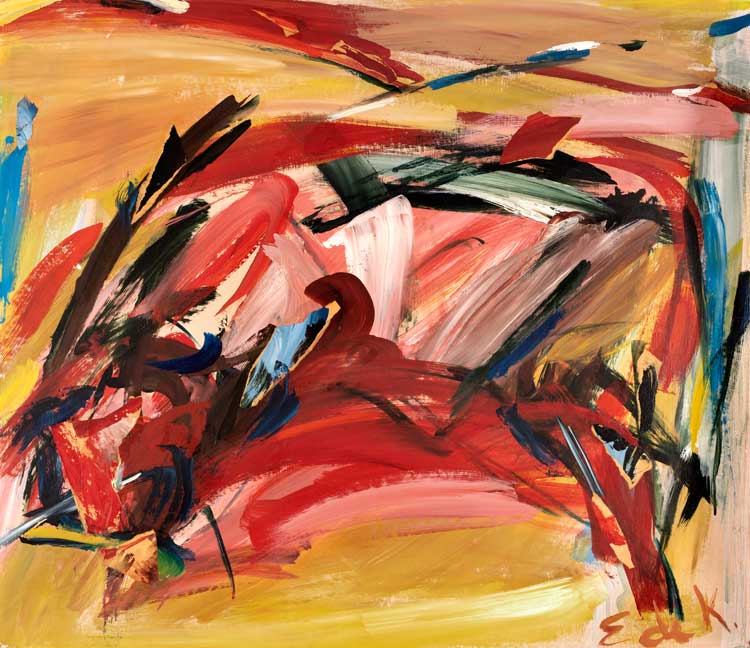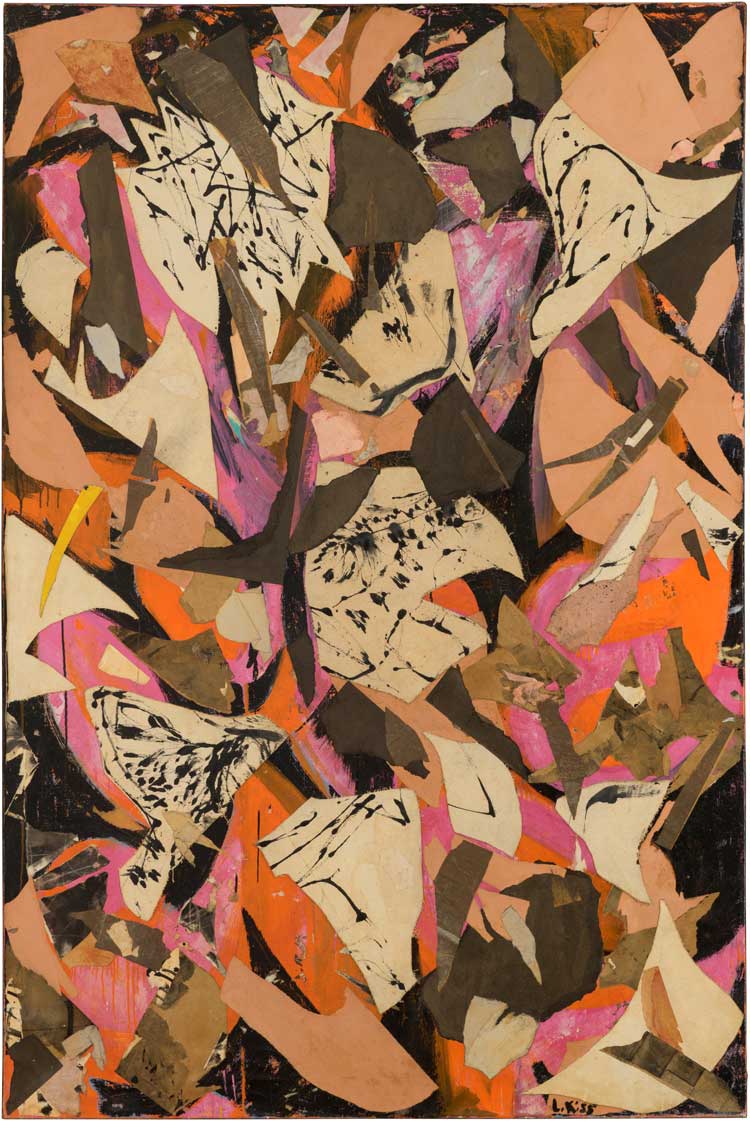.jpg)
Janet Sobel, Untitled, c1948 (detail). Mixed media on canvas board, 76.2 x 50.8 cm. Courtesy The Christian Levett Collection.
Whitechapel Gallery, London
9 February – 7 May 2023
by BETH WILLIAMSON
For a long time now, probably since its inception in the 1940s, the machismo of US action painting has seen it as just that, an American and very masculine endeavour. Over the years the mythologies that have built up around the careers of painters such as Jackson Pollock (1912-56), Willem de Kooning (1904-97) and their ilk has sustained a story driven by ideas of masculinity. The process of gestural brush strokes, dripping and pouring, has become synonymous with abstract expressionism, where artists channel their unconscious on to the canvas. Pollock, for instance, insisted that the rhythmic quality of his painted images presented something of the energy and movement within the psyche, a surfacing of the unconscious in contact with the material presence of the medium.

Elaine de Kooning, The Bull, 1959. Acrylic and collage on Masonite, 76.2 x 88.9 cm. Courtesy The Christian Levett Collection. © EdeK Trust.
In 1958, Pollock’s retrospective at the Whitechapel Gallery received mixed reviews. Sixty-five years later, the present exhibition will no doubt receive mixed reviews, too, but perhaps for different reasons. The intervening years have seen repeated attempts to elevate the work of the better-known female abstract painters of the period, often the wives and partners of their male counterparts: Helen Frankenthaler (1928-2011), Elaine de Kooning (1918-89), Lee Krasner (1908-84). Still, they have generally been known in relation to that male-dominated field, not artists worthy of equal consideration, but female artists and of less value because of that. It is only very recently that female artists of the past have begun to take their rightful place in art histories.

Lee Krasner, Bald Eagle, 1955. Oil, paper, and canvas collage on linen,
195.6 x 130.8 cm. Courtesy of ASOM Collection. © 2022 Pollock-Krasner Foundation / Artists Rights Society (ARS), New York.
Action, Gesture, Paint takes these women out of that historically unfavourable comparative framework. In fact, it takes them out of any comparative framework at all by simply presenting them alongside other figures worldwide. With about 80 international female artists and 150 paintings this is a comprehensive show that presents these women as artistic equals in an old-style painting exhibition with galleries full to overflowing. The personal and political freedom of this approach in the postwar period can be seen to have reached across the globe and be found in unexpected places with more than half the works shown never having been on public display in the UK. It is a rare thing, too, to be introduced to the work of so many artists you have never encountered previously, and in a single exhibition. It is thrilling, to be honest.

Helen Frankenthaler, April Mood, 1974. Acrylic on canvas, 152 x 434 cm. Courtesy of ASOM Collection. © Helen Frankenthaler Foundation, Inc. / ARS, NY and DACS, London 2022.
Starting the exhibition with Frankenthaler’s April Mood (1974) makes for a powerful beginning. At about four metres long, its impact is undeniable in this first section of the exhibition, titled “Material Process Time”, dealing with how these artists explored the materiality of the paint, incorporated found materials and created mutable surfaces. The other themed sections are “Myth Symbol Ritual”, “Being Expression Empathy” and “Performance Gesture Rhythm”. There is also an unnamed section, presumably for works that don’t sit comfortably elsewhere.
It is difficult to impose themes on this sort of work and there are instances where individual works might fit equally well in other thematic categories. Still, these groupings are helpful for gallery visitors navigating their way through this work, especially when a great deal of it has not been seen in the UK previously. It is especially courageous to include the untitled section, what might be thought of as a catch-all. A more charitable perspective might take the view that this reflects the nature of the show itself as it deals with the unknown, unnamed or largely forgotten women of gestural abstraction. Just as the work of these female artists does not need to be aligned or even considered beside their male counterparts, nor does it necessarily need to fit curatorial themes – it is the ultimate freedom, perhaps, to exists outside of these strictures, but still be included.

Fanny Sanín, Oil No. 4, 1968. Oil on canvas, 157 x 150 cm. Courtesy of Elisa Yu Collection. © Fanny Sanín.
There are far too many new and fascinating artists to mention here, but there are some who cannot go unnamed in the present context. The Colombian Fanny Sanin (b1938), who studied art in Bogotá before undertaking graduate studies in the US and Mexico, began her experiments with gestural abstraction during a two-year period in London in the 1960s. The delicate paintings of the Italian Bice Lazzari (1900-81) explore a range of materials from pencil and watercolour, to tempera, glue, oil and sand. The Hungarian Judit Reigl (1923-2020) studied at the Hungarian University of Fine Arts in Budapest, later studying in Rome and moving to Paris where she encountered the ideas of André Breton (1896-1966) before developing a process of gestural abstraction. From the mid-1950s, the Scottish painter Margaret Mellis (1914-2009) used pure gestural colour in works such as the wonderfully evocative Plant (Black, Umber, Orange) (1960) included here. The Ukrainian Janet Sobel (1893-1968) dripped enamel paint directly on to the canvas using a glass pipette. Her paintings were seen in the 1940s by Pollock and the critic Clement Greenberg, who only acknowledged her influence much later. The Venezuelan Mercedes Pardo (1921-2005) produced vibrant explorations of colour. Toko Shinoda (1913-2021) spent two years in New York in the 1950s and in her prints and lithographs fused and expressionist approach with calligraphic skills. In five works from the 70s, Shinoda uses sumi ink on traditional Chinese and Japanese papers with the energy of gestural abstraction. The psychological paintings of the Danish artist Else Fischer-Hansen (1905-96) are a joy.
There are artists old and new to surprise everyone in this show. From the reconsideration of British artists such as Elsa Vaudrey (1905-90), Lilian Holt (1898-1983) and Gillian Ayres (1930-2018), to the lesser-known abstract expressionist women of Korea and Mozambique, Israel and Iran, this is an exhibition that sends you home with more questions than answers and with the enthusiasm to discover more. What more could you ask?